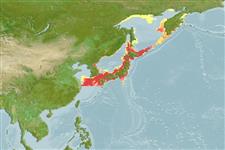Common names from other countries
Classification / Names / Names
ماع يماسا | فدارتم | Catalog of Fishes (gen., sp.) | ITIS | CoL | WoRMS
Environment: milieu / climate zone / depth range / distribution range
يسانش موب
; قمع تارييغت 0 - 200 m (Ref. 635), usually 50 - 100 m (Ref. 635). Subtropical; ? - 30°C (Ref. 77134), preferred 16°C (Ref. 107945); 63°N - 31°N, 117°E - 165°E (Ref. 112755)
Northwest Pacific: Japan (from Hokkaido to Kyushu), China, Korean Peninsula and Far Eastern Russia (Karaginskogo Island).
Length at first maturity / Size / Weight / نس
Maturity: Lm ?, range 20 - ? cm Max length : 30.0 cm TL يسنج صاوخ نودب / رن سنج; (Ref. 101467)
Common in shallow coastal bottom communities from the intertidal zone to depths more than 100 m. Forms aggregations, usually in the upper sublittoral zone (Ref. 635). May occur in three color variants: red type often found in offshore gravel beds while the green and black types often at inshore sandy-muddy bottoms (Ref. 77132). Juveniles often associated with algal/seagrass and oyster beds (Ref. 621). Most commercially important sea cucumber species (for trade, food and traditional medicine both; fisheries and farming/ranching) in China (Ref. 77133). Aquaculture now widespread in northern coast of China (Ref. 77133) since wild populations became over-exploited in the 1990s. Chinese aquaculture production peaked at 65,283 tons in 2005 (Ref. 77133).
Life cycle and mating behavior
غولب | لثم دیلوت | یزیر مخت | اه مخت | Fecundity | )ورال ( دازوت
Members of the class Holothuroidea are gonochoric and have only one gonad. Spawning and fertilization are both external and some exhibit brooding. Life cycle: Embryos develop into planktotrophic larvae (auricularia) then into doliolaria (barrel-shaped stage) which later metamorphose into juvenile sea cucumbers.
یلصا ذخآم
عجارم | هدننك گنهامه | ناراكمه
Kan-no, M. and A. Kijima. 2003. (Ref. 77132)
NCUI زمرق تسرهف رد تيعضو (Ref. 130435: Version 2024-1)
ستياس رظن زا تيعضو (Ref. 108899)
Not Evaluated
Not Evaluated
اه ناسنا یارب رطخ
Harmless
یناسنا هدافتسا
تاليش – يريگ يهام: يراجت; يرورپ يزبآ: يراجت
FAO - يرورپ يزبآ: production, هنوگ هيامن; تاليش – يريگ يهام: landings | FishSource | Sea Around Us
اهرازبا
يتنرتنيا عبانم
Estimates based on models
Preferred temperature
(Ref.
115969): 8.6 - 19.7, mean 15.2 (based on 30 cells).
یريذپ بيسآ
Low to moderate vulnerability (35 of 100).
